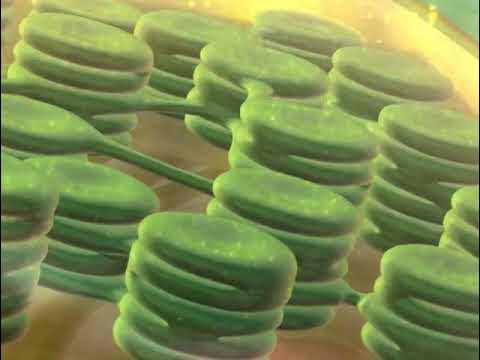Seven Life Processes | Physiology | Biology | FuseSchool
Summary
TLDRThis script explores the remarkable diversity of life on Earth, highlighting the seven fundamental life processes shared by all living organisms. It emphasizes movement, respiration, sensitivity, growth, reproduction, excretion, and nutrition, illustrating how each process, from the swift cheetah to the expansive honey fungus, contributes to the intricate balance of life. The memorable acronym 'MRS GREN' encapsulates these processes, offering a simple way to understand the complex tapestry of life on our planet.
Takeaways
- 🌏 The Earth is home to an astonishing diversity of life, with an estimated 5 to 10 million different species, excluding bacteria due to their difficulty to count.
- 🏃♂️ All living organisms, from amoebas to giraffes, can move in some way, with some like the cheetah moving at high speeds and others like plants moving more slowly.
- 🔥 Respiration is a universal cellular process that releases energy stored in food, essential for all life forms to survive.
- 👀 Sensitivity, or the ability to sense the environment, is crucial for organisms to find food, shelter, or avoid predators, with humans having five distinct senses.
- 🌱 Growth is a characteristic of all organisms, with some like the honey fungus in Oregon being the largest living organism, spanning 2.4 miles.
- 💑 Reproduction is a key life process, with organisms using either asexual or sexual methods to propagate, varying greatly in the time it takes to reproduce.
- 🚰 Excretion is the process of eliminating waste products from chemical reactions within the organism, different from egestion.
- 🌱 Nutrition is the process by which all living organisms obtain the food they need, with plants being unique in making their own food through photosynthesis.
- 🧠 The seven life processes can be remembered by the acronym 'MRS GREN': Movement, Respiration, Sensitivity, Growth, Reproduction, Excretion, and Nutrition.
- 🎓 Understanding these processes is fundamental to grasping what makes something a living thing, as they are common to all forms of life on Earth.
Q & A
What is the estimated number of living species on Earth?
-There are an estimated five to ten million different living species on Earth, excluding bacteria due to the difficulty in counting them.
What are the seven life processes that all living things can carry out?
-The seven life processes are movement, respiration, sensitivity, growth, reproduction, excretion, and nutrition.
How does a cheetah demonstrate the life process of movement?
-The cheetah demonstrates movement as it is the fastest animal on the planet, capable of running at speeds up to 60 miles per hour.
What is the role of respiration in living organisms?
-Respiration is a cellular process that releases energy stored in food, which all living organisms need to sustain life.
Why is sensitivity important for a living organism's survival?
-Sensitivity allows an organism to sense its environment, which is crucial for finding food, shelter, or avoiding predators.
What is the difference between growth in basic and complex organisms?
-In basic organisms, growth involves cells getting bigger, while in complex organisms, it involves the increase in the number of cells.
What is the largest living organism on Earth, and what type of organism is it?
-The largest living organism on Earth is a type of honey fungus growing in Oregon, which is thought to be 2.4 miles across.
What are the two types of reproduction mentioned in the script?
-The two types of reproduction mentioned are asexual reproduction, which some organisms like bacteria can do on their own, and sexual reproduction, which requires a male and female of the species.
How often can bacteria reproduce, and how does this compare to the gestation period of an African elephant?
-Bacteria can reproduce every 20 minutes, which is significantly faster compared to the 22-month gestation period of an African elephant.
What is the difference between excretion and egestion?
-Excretion refers to the process of getting rid of waste from chemical reactions within the organism, while egestion is the process of expelling undigested food from the body.
How do plants obtain their food, and what is this process called?
-Plants obtain their food through the process of photosynthesis, where they convert sunlight, carbon dioxide, and water into glucose and oxygen.
What is the acronym 'MRS GREN' used for in the script, and what does it represent?
-The acronym 'MRS GREN' is used to help remember the seven life processes: Movement, Respiration, Sensitivity, Growth, Reproduction, Excretion, and Nutrition.
Outlines

This section is available to paid users only. Please upgrade to access this part.
Upgrade NowMindmap

This section is available to paid users only. Please upgrade to access this part.
Upgrade NowKeywords

This section is available to paid users only. Please upgrade to access this part.
Upgrade NowHighlights

This section is available to paid users only. Please upgrade to access this part.
Upgrade NowTranscripts

This section is available to paid users only. Please upgrade to access this part.
Upgrade NowBrowse More Related Video

Introduction to Biology: Crash Course Biology #1

A2.2 Cell Structures and Processes [IB Biology SL/HL]

BioFlix 3D Animations for Mastering Biology

Projetada para a vida Parte 1 | Origens #9

What is the Smallest Organism on Earth? | Wonders of Life w/ Prof Brian Cox | BBC Earth

SHS Science Classification of Organisms
5.0 / 5 (0 votes)